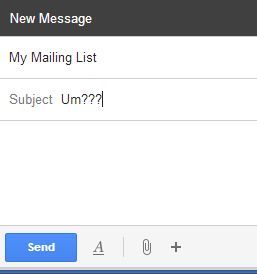 If eyes are the windows to the soul, then subject lines are the path to successful email marketing. Romantic, huh?
If eyes are the windows to the soul, then subject lines are the path to successful email marketing. Romantic, huh?
Guest blogger Betsy Glickman wrote an inspiring post last month, 4 Tips for Creating a Compelling Email Pitch, and her first tip—crafting a superlative subject line—stayed with me. Most of us know how to write a subject line, but we get hung up on creating the perfect first impression. Writing a quality subject line takes practice and know-how. Keep these tips in mind before you send your next campaign.
Make it brief. Writing a subject line that is 50 characters or less is generally recommended, as some mail clients may cut off subject lines that are longer. According to MailChimp, subject lines that are 28-39 characters have the highest open rate. The exception is for highly targeted audiences.
Say what’s in the email. Don’t worry about being funny or catchy—being direct with your recipients is far more effective. One study found that a clear subject line gets 541 percent more clicks than one that’s clever.
Appeal to your audience. What does your mailing list have in common? What’s relevant to these recipients? It could be that these people all work in the same industry, have similar interests, or live in the same area. Work from the common thread. “Parks Department Newsletter—July 2013” might not entice your audience in the way that “Learn how to garden at Lincoln County’s 14 parks” will.
Lay off the sales jargon. You don’t want to try to sell something in the subject line. Instead, convey a story or a benefit to the reader. Your subject line shouldn’t bombard the recipient with products, deals or flashy promises. Use the subject line to relate to the reader and gracefully funnel him or her to the rest of your content—and ultimately your call-to-action.
Play the numbers game. Lists are an effective way to grab someone’s attention. Signal’s blog recommends numbered lists because “they immediately communicate two things: the inherent value in the email that’s being sent, and how long it’s going to take to digest it.” I fall victim to these every time, whether it’s “5 Most Anticipated Restaurant Openings in Chicago” or “10 Easy Personal Finance Tips for Twenty-Somethings.”
Don’t be shady. Never trick someone into reading your email. Don’t use “Fwd:” in a subject line pretending it’s an email from a trusted sender. Don’t request help in the subject line—it’s a cry-wolf that triggers a scam-sense in people (it’s like Spidey-sense), as in, “Help this Nigerian prince” or “Help Bill Gates spend his fortune.” If someone feels betrayed by your subject line when they read the content of your email, the relationship won’t evolve.
Avoid spam filter words. Steer clear of words that may send your mailing to the depths of spam folder purgatory. “Free” is a one of the biggest offenders, as are “percent off,” “reminder” and excessive punctuation. Check out this StartupNation post for more words to omit from subject lines.
Check it twice. You don’t want a spelling, grammar or factual error going out to 5,000 people at once and undermining your message. Have you been on the receiving end of a subject line such as, “Correction: Sale starts Friday, not today” or “Update to previous email: event information included”? Retractions and follow-up emails don’t look great for the brand, so take the time to proofread before sending.
Pay attention to open rates. This is the biggest indication as to whether your subject lines are working the way you’d like. Glickman says it’s important to have realistic expectations for open rates, as benchmarks may be highly dependent on your industry. She recommends consulting research on campaign statistics, like this email marketing benchmark list from MailChimp.
Try new things. Are your open rates not where they should be? Think your subject lines are scaring off readers or customers? Tweak them. Rewrite them. Change them until you find subject lines (and content to support them) that work. Keep in mind, once-high rates may decline, and you may need to freshen up your mailings and subsequent subject lines with a new feature or hook.
Teresa Dankowski is the Community Manager for SeekorShout.com, Cision’s social networking platform for PR and media. Prior to joining Cision in 2007, she was a reporter, fact checker and columnist—née “the intern who wouldn’t leave”—for Chicago Parent. In her spare time, Teresa is an amateur printmaker, three-season softball player, bar trivia host and freelance journalist. She has a bachelor’s degree in journalism from Northwestern University.